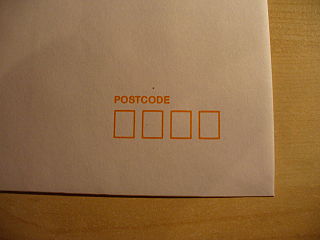Related Research Articles

An abugida, sometimes known as alphasyllabary, neosyllabary or pseudo-alphabet, is a segmental writing system in which consonant-vowel sequences are written as units; each unit is based on a consonant letter, and vowel notation is secondary. This contrasts with a full alphabet, in which vowels have status equal to consonants, and with an abjad, in which vowel marking is absent, partial, or optional. The terms also contrast them with a syllabary, in which the symbols cannot be split into separate consonants and vowels.
Observational error is the difference between a measured value of a quantity and its true value. In statistics, an error is not necessarily a "mistake". Variability is an inherent part of the results of measurements and of the measurement process.
0 (zero) is a number, and the numerical digit used to represent that number in numerals. It fulfills a central role in mathematics as the additive identity of the integers, real numbers, and many other algebraic structures. As a digit, 0 is used as a placeholder in place value systems. Names for the number 0 in English include zero, nought (UK), naught, nil, or—in contexts where at least one adjacent digit distinguishes it from the letter "O"—oh or o. Informal or slang terms for zero include zilch and zip. Ought and aught, as well as cipher, have also been used historically.

The Brahmic scripts, also known as Indic scripts, are a family of abugida writing systems. They are used throughout the Indian subcontinent, Southeast Asia and parts of East Asia. They are descended from the Brahmi script of ancient India and are used by various languages in several language families in South, East and Southeast Asia: Indo-Aryan, Dravidian, Tibeto-Burman, Mongolic, Austroasiatic, Austronesian, and Tai. They were also the source of the dictionary order (gojūon) of Japanese kana.
The Fermi energy is a concept in quantum mechanics usually referring to the energy difference between the highest and lowest occupied single-particle states in a quantum system of non-interacting fermions at absolute zero temperature. In a Fermi gas, the lowest occupied state is taken to have zero kinetic energy, whereas in a metal, the lowest occupied state is typically taken to mean the bottom of the conduction band.
In inferential statistics, the null hypothesis is that two possibilities are the same. The null hypothesis is that the observed difference is due to chance alone. Using statistical tests, it is possible to calculate the likelihood that the null hypothesis is true.
In null-hypothesis significance testing, the p-value is the probability of obtaining test results at least as extreme as the result actually observed, under the assumption that the null hypothesis is correct. A very small p-value means that such an extreme observed outcome would be very unlikely under the null hypothesis. Reporting p-values of statistical tests is common practice in academic publications of many quantitative fields. Since the precise meaning of p-value is hard to grasp, misuse is widespread and has been a major topic in metascience.
Virama is a Sanskrit phonological concept to suppress the inherent vowel that otherwise occurs with every consonant letter, commonly used as a generic term for a codepoint in Unicode, representing either
- halanta or explicit virāma, a diacritic in many Brahmic scripts, including the Devanagari and Eastern Nagari scripts, or
- saṃyuktākṣara or implicit virama, a conjunct consonant or ligature.
Embedded Zerotrees of Wavelet transforms (EZW) is a lossy image compression algorithm. At low bit rates, i.e. high compression ratios, most of the coefficients produced by a subband transform will be zero, or very close to zero. This occurs because "real world" images tend to contain mostly low frequency information. However where high frequency information does occur this is particularly important in terms of human perception of the image quality, and thus must be represented accurately in any high quality coding scheme.
The Wilcoxon signed-rank test is a non-parametric statistical hypothesis test used either to test the location of a population based on a sample of data, or to compare the locations of two populations using two matched samples. The one-sample version serves a purpose similar to that of the one-sample Student's t-test. For two matched samples, it is a paired difference test like the paired Student's t-test. The Wilcoxon test can be a good alternative to the t-test when population means are not of interest; for example, when one wishes to test whether a population's median is nonzero, or whether there is a better than 50% chance that a sample from one population is greater than a sample from another population.

A servomotor is a rotary actuator or linear actuator that allows for precise control of angular or linear position, velocity and acceleration. It consists of a suitable motor coupled to a sensor for position feedback. It also requires a relatively sophisticated controller, often a dedicated module designed specifically for use with servomotors.

The Milne model was a special-relativistic cosmological model proposed by Edward Arthur Milne in 1935. It is mathematically equivalent to a special case of the FLRW model in the limit of zero energy density and it obeys the cosmological principle. The Milne model is also similar to Rindler space, a simple re-parameterization of flat Minkowski space.

The Lepcha script, or Róng script, is an abugida used by the Lepcha people to write the Lepcha language. Unusually for an abugida, syllable-final consonants are written as diacritics.

A solid state relay (SSR) is an electronic switching device that switches on or off when an external voltage is applied across its control terminals. They serve the same function as an electromechanical relay, but as solid-state electronics contain no moving parts and have a longer operational lifetime.
In mathematics and statistics, deviation is a measure of difference between the observed value of a variable and some other value, often that variable's mean. The sign of the deviation reports the direction of that difference. The magnitude of the value indicates the size of the difference.
The phrase "inherent bias" refers to the effect of underlying factors or assumptions that skew viewpoints of a subject under discussion. There are multiple formal definitions of "inherent bias" which depend on the particular field of study.

Postcodes in Australia are used to more efficiently sort and route mail within the Australian postal system. Postcodes in Australia have four digits and are placed at the end of the Australian address, before the country. Postcodes were introduced in Australia in 1967 by the Postmaster-General's Department and are now managed by Australia Post, Australia's national postal service. Postcodes are published in booklets available from post offices or online from the Australia Post website.
Open-source software security is the measure of assurance or guarantee in the freedom from danger and risk inherent to an open-source software system.

Katana Zero is a 2019 platform game created by the indie developer Justin Stander. Set in the dystopian neo-noir metropolis of New Mecca, it follows Subject Zero, a katana-wielding assassin with amnesia who can slow down time and predict the future. Zero unravels his past while completing assassination contracts. Katana Zero features side-scrolling hack-and-slash gameplay in which the player attempts to kill all enemies in a level without being hit. The player uses Zero's abilities to manipulate time, dodge attacks, and take advantage of environmental hazards. Outside the main gameplay, the player converses with non-player characters through dialogue trees.

World energy supply and consumption is global production and preparation of fuel, generation of electricity, energy transport, and energy consumption. It is a basic part of economic activity. It includes heat, but not energy from food.
References
- ↑ Elementary Statistics: Picturing the World by Ron Larson and Elizabeth Farber